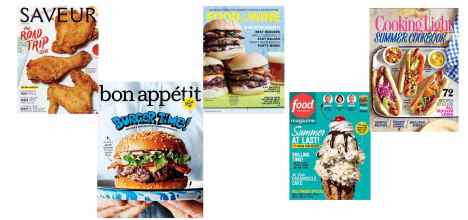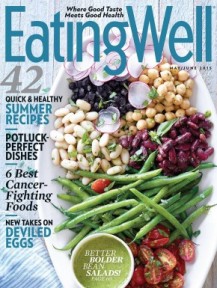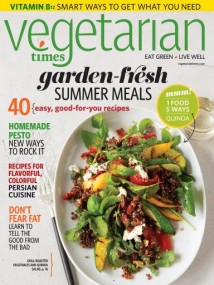It’s nearly June, the big northeast snowfest that lasted into April is pretty much over, and all the May and June issues of the big food magazines are showing…almost no fresh vegetables on the covers. Or inside. Oh, you do see some green–but it’s garnish. Flat-leaf parsley, a little cilantro, a sprig of basil maybe, chopped or torn over the cover dish to make it pretty. But very few actual vegetables–take a little walk with me down the newsstand for a sec.

All magazine cover thumbnails shown have been lifted shamelessly–they’re not mine, they’re the property of their respective publishers–and pasted together here solely for parody value and critical review of the food literature.
Saveur? Fried chicken. Seriously. Cooking Light? Hotdog special–one with a slice of pickle and tomato, another with avocado, to represent Vietnamese and Mexican, respectively. Whoo-don’t you feel like a world traveler now. Food and Wine? Burgers by Bobby Flay. Bon Appétit? Another burger. Food Network? They don’t even pretend. Ice cream cone. With whipped cream and a cherry on top. On a cone.
The women’s mags are leaning toward desserts: Martha Stewart–cake. Southern Living, Allrecipes–pie. Better Homes & Gardens and BHG Diabetic Living both feature watermelon and ice cream or sorbet assortments. All of it very pink.
 |
 |
But even EatingWell and Vegetarian Times aren’t doing all that much vegetabalia on their green-looking covers. EW has a vegetable serving platter with a nice looking bunch of raw green beans and tomatoes at the bottom, but more than half of the platter is canned beans or dip. Not that I’m against those, but they really aren’t fresh veg. VT has a grilled veg and quinoa salad platter that looks wholesome enough, but if you zoom in for a closer look you realize it’s not mostly veg either. If you took a quarter of it for yourself, you’d only get 3 or 4 thin slices of pepper and zucchini on your plate along with the grain. Most of the green you see in the picture is a token sprinkling of arugula and basil sprigs strewn over the top–a strategy that’s being used and abused in the less veg-forward pubs to make steak or pork loin or mac ‘n’ cheese look like they have something fresh and healthy about them.
Lucky Peach and Cook’s Illustrated both go for graphics rather than photos. LP has a cartoony poster graphic of garden lushness for “The Plant Issue”–do they really have vegetabalia inside? Cook’s Illustrated has a pastel of radishes.
It’s as though they all decided to try to look summery without including actual bulk greens–the signature of summer (well, other than watermelon). I’ve complained about this before, I know, but back then I was talking about friends who don’t cook much and are somewhat veg-phobic, not about upscale food media. For years the food glam world has been touting local sourcing, farmers’ markets, heirloom this and that, Provençal and Spanish and Italian and Middle Eastern cuisines, which are full of vegetables one way and another. But they really are no longer practicing what they preach. They’ve shrunk their focus down to the meager American fast food paradigm while pretending otherwise. And charging you between 4 and 10 dollars an issue.
But vegetables are so easy to ruin, you say. The green ones turn brownish olive if you hold them too long after cooking. If you’re going to hang around a whole hour waiting for the photographer to get the right shot, you’re going to have to cook a couple of batches in a row. Strewing a couple of sprigs of cilantro or parsley over something is so much easier!
The other reason we’re not seeing vegetables on the magazine covers: editorial production lag. Monthly magazines typically take anything from 2-6 months to produce from start to finish, so they work ahead. The May and June issues probably went to press two months ago, when it had barely stopped snowing in the northeast (per my mother and sister). Summer vegetables are not bountiful in March and April under those conditions–at least not in New York and Boston. But the editors could have put together something decent and thematic for the covers if they wanted to–I’m pretty sure I could have sent them a likely looking CARE package from my local greengrocer’s if they’d only asked and were willing to foot the overnight shipping.

Eat your heart out, foodie magazines! Time to gloat. A typical weekly haul from my greengrocer comes in at under $30 even with a pound of coffee or tehina or yogurt (not shown, obviously), bagged spices, dried beans, and specials on fruit or nuts. When the tomatoes are better I stagger out the door with 5-10 lbs. at a time, but on the other hand the snow peas were a serious bargain this time around.
There are plenty of good vegetables around. Fresno tomatoes are back in my Armenian grocery (for which, oh! be joyful), we have green and romano beans, we have lettuces and purslane and bunches of fresh basil and dill and mint and za’atar (and yes, parsley, but here I mean the whole bunch for Lebanese-style very-green tabbouleh, not a lousy single sprig of garnish). Also the standard year-round bulk staple produce at about a dollar a pound on average, at least at the greengrocer’s.
These are things that never make the newsstand because they’re not chic or brandable and because they’re not exclusive enough for high-end restaurants to flaunt. Or put in $18 cocktails. Anyone can buy and cook them, you don’t have to be rich and snotty: cabbages, cucumbers, broccoli and cauliflower and carrots and onions and red and yellow and green bell peppers, plus Anaheims and jalapeños. And zucchini and regular red radishes and butternut and spaghetti squash. And eggplants of four or five varieties. At the Ralph’s (Kroger affiliate), the dollar-a-pound selection includes regular bok choy and Nappa cabbage, even though peppers, snap peas and green beans are 2-3 dollars a pound. And I note with satisfaction that the baby bok choy price has come down from $3 to $1.50 a pound lately. Regular is still the better buy, but it’s not as outrageous as last year.
Maybe they’re not as pretty as last year’s must-have fashion vegetable, the watermelon radish. Or maybe the food editors have run out of decent ideas and are chasing their own tails again. Too much damn fast food at the office on copyediting days; too much restaurant-think on interview and photography days. Too little variety. Too much stodge, and only token representation of the name-droppable must-haves: Kale chip this, quinoa that, three tiny cubes of butternut squash floating in a cream soup…meticulously slivered asparagus stalks to garnish something that is mostly not a vegetable dish but rather a vehicle for eggs, cream, cheese, pasta or bacon. Sometimes all five at once.
Cookbooks seem to be having the same moment. April Bloomfield of The Spotted Pig (and A Girl and Her Pig) has a new one out on vegetables, A Girl and Her Greens (HarperCollins, 2015). Not mostly potatoes–though she has several potato recipes. Because she’s British, maybe, there are a lot of peas. And turnips and rutabagas. Half-starchy to definitely starchy, with a few lettuces and things thrown in. A section on “vegetables with cream” (creamed spinach, potato gratin, morels in cream on toast) which gives her the excuse to include…sweetcorn ice cream with some sort of caramel sauce. And caramel popcorn.
A few other recent cookbooks, blog or celebrity chef-based, claim to be about veg but include either a suspiciously large number of recipes with fruit or else the odd recipe for superpremium mint ice cream (because the authors grew their own mint in the backyard) or lemon-basil sorbet (same premise) or else, even further-fetched, brownies that involve baked beans or the like. . . . you see where I’m going with this?
Since when does pizza with a few token shreds of wilted broccolini or arugula leaves dying on it count as a vegetable? Since when is mint ice cream a vegetable? Since when are brownies anything but dessert? Why are the two first sections of Bon Appétit‘s recipe page always cocktails and desserts, in that order. Why are the vegetable dishes perpetually last and least?
If you look beyond the parsley at any of the featured plates in the mags, on cooking shows, book covers, wherever, you can see how empty a gesture it is: you get much less than an actual serving of nonstarchy greens (half a cup cooked, a whole cup raw) per person at any meal. To say nothing of the nutritionally recommended half the plate worth. Half a stalk of asparagus slivers and a tablespoon of peas per plate does not a feature salad make.
This is exactly the problem: The nominal feature vegetables are turned into arty-looking shavings and used as garnish–does a table for four get more than a shared single radish cut in paper-thin slices as though it were a black truffle? Melissa Clark did this kind of stunt for a spring salad video at the New York Times a few weeks ago, and she donned a mesh safety glove to protect her hand a little from getting mandolined along with the lone radish–the slicer disk on her food processor wasn’t fine enough, apparently. It looked like very slow going, the glove still got shredded nastily, and for what? Something with the consistency, look and nutritional value of gift tissue wrap.
Is all this vegetable parsimony out of concern for the food staging budget? Most standard vegetables are considerably cheaper per pound retail than scallops, shrimp, pork belly, pancetta, steak, duck breast and all the other trophy items they pile up for the picture.
Vegetables other than heirloom are cheaper per pound than anything but eggs, tofu, dried beans or pasta, to tell you the exact truth. True, we’re seeing a lot of fried or poached eggs photographed artily on things that otherwise aren’t quite there yet as recipes, or else on dishes that don’t really require eggs for completeness–it’s kind of a shorthand for craft cooking, a meme or trope or something. Plus the bright yellow-and-white bullseye effect, you know. Mostly it’s clickbait for Pinterest–even one of mine from several years ago (the microwave-poached eggs on a salad) has gotten pinned. I didn’t even know about Pinterest at that point.
The main green accent other than parsley these days seems to be avocado. Which is okay for what it is, an accent or condiment as in guacamole, but with the understanding that it’s not really a bulk green vegetable. Very fatty, not much else to recommend it but its shape and color. Photogenic.
So of course this month Cooking Light is featuring an extreme example of this clickbait-over-commonsense motif with an unexpected side article: deep-fried breaded avocado wedges. Which they describe as “silky-rich”. Yeah. Sorry about that, I should have warned you. I guess they figure that avocado is green, so rolling it in breadcrumbs and deep-frying somehow magically spells light, fresh and healthy? Even though it’s bound to taste like one of those gross-yourself-out deep-fried novelties you’d only find or try at the county fair.
I think I’ll stick with a salad, thanks. Or maybe some broccoli with mustard dressing.
Filed under: cooking, Food Magazines, frugality, shopping, Vegetabalia | Tagged: celebrity chefs, food, food magazines, Food Politics, frugality, nutrition, vegetables |




Seems to me that veg foods aren’t featured because they don’t sell magazines or articles. Compared with meats, grains, and other starchy foods, and of course desserts, they are considered boring, non-substantive, appetite-unsatisfying, and requiring too much work to prepare and then to chew. Nothing new here. Haven’t they always been the ought-to-eat foods rather than the want-to-eat foods? The want-to-eats sell and the ought-to-eats don’t, and what sells is what the magazines are interested in. We should be thankful for this. If everyone ate the suggested quantities of veggies each day, there probably wouldn’t be enough to go around.
Sadly true. Produce growers aren’t big advertisers, and the meat industry is. The food media would be okay with me if they were mostly focused on restaurant reviews or the like and not pretending so much to be arbiters of home cooking and nutrition. Mostly I object to the fashion values being imposed and look what it’s led to over the past decade: people are afraid to cook or even buy bulk vegetables anymore. Whenever I go to the supermarket, there’s some lost soul standing miserably in front of the bunches of kale wondering if they really have to buy some just to be socially acceptable, because they don’t really know how to cook it and all they can remember, if they’re old enough, is the long-cooked slimy sulfurous stuff the school cafeterias used to serve. You shouldn’t need chef-level knife skills to make a green salad, and you shouldn’t believe you really need to get your broccoli from a sealed package of dried-out florets at three times the price of bulk because washing and cutting up a stalk of broccoli is too difficult to do for yourself. Or that you’re somehow a societal and fashion failure if you like ordinary romaine more than kale.
I tend to think that some types of foods are simply more palatable than others, and that that explains most of the common preferences. Even a lowland gorilla would probably rather eat a Happy Meal than a salad. Media and food companies do not, imo, determine our tastes; rather they pander to what comes naturally to us. If they didn’t, they’d go out of business. They aren’t health educators. Parents, and perhaps schools, play that role. Education is the key: learn to choose a good diet, and learn to cook. My mom (bless her and her otherwise good culinary skills, and ever the nutrition educator) usually over-cooked the sulfur veggies and perhaps as a result, I didn’t want to go near them until I was in my 20s. 🙂
You were lucky to have someone cook real food at home, even if they weren’t good at vegetables (neither was my mom; my sister and I also learned fast how to rescue dinner by offering to cook any hamburger meat she brought home so she wouldn’t turn it into dry, gray balls of dirt…) But if you really believe food companies don’t do anything more than pander to pre-existing common taste, you should check two fascinating books: David Kessler’s The End of Overeating. and Michael Moss’s Salt Sugar Fat–for a shorter but still in-depth look at fast food and processed food, see this article of his from the NYTimes.